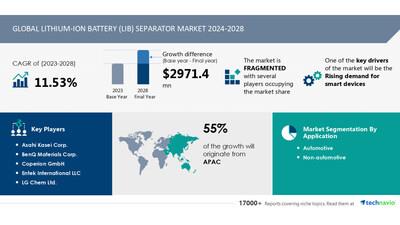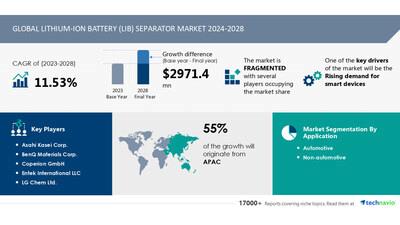
Lithium-Ion Battery (LIB) Separator Market Size Is Set To Grow By USD 2.97 Billion From 2024-2028, Rising Demand For Smart Devices Boost The Market, Technavio
| Lithium-Ion Battery (Lib) Separator Market Scope |
|
| Report Coverage |
Details |
| Base year |
2023 |
| Historic period |
2018 - 2022 |
| Forecast period |
2024-2028 |
| Growth momentum & CAGR |
Accelerate at a CAGR of 11.53% |
| Market growth 2024-2028 |
USD 2971.4 million |
| Market structure |
Fragmented |
| YoY growth 2022-2023 (%) |
10.45 |
| Regional analysis |
APAC, Europe, North America, Middle East and Africa, and South America |
| Performing market contribution |
APAC at 55% |
| Key countries |
China, US, Germany, Japan, and India |
| Key companies profiled |
Asahi Kasei Corp., BenQ Materials Corp., Coperion GmbH, Entek International LLC, LG Chem Ltd., Mitsubishi Paper Mills Ltd., MOD PLAST INDUSTRIES, Semcorp., SK Innovation Co. Ltd., Solvay SA, Sumitomo Chemical Co. Ltd., Targray Technology International Inc., TDK Corp., Teijin Ltd., Thermo Fisher Scientific Inc., Toray Industries Inc., Ube Corp., W-SCOPE Corp., Xiamen Lith Machine Ltd., and Yasui Seiki Co. Ltd. |
Market Driver
Lithium-ion battery separators are essential components, available in two types: dry and wet. The manufacturing process involves extrusion for film preparation and stretching for porous structure formation. Dry separators, used in automotive applications, have slit-like micropores and a straight structure. Wet separators, popular in consumer electronics, have a tortuous structure and interconnected micropores, preventing dendrite growth. Wet separators are thinner and stronger, with advantages like increased energy density and improved safety through ceramic coatings. The automotive industry's growing need for longer EV and PHEV ranges drives wet separator adoption, boosting the global LIB separator market.
The Lithium-Ion Battery (LIB) separator market is experiencing significant growth due to increasing trends in automotive and battery-operated medical devices. Automakers are investing heavily in EVs, driving demand for high-performance LIBs with long cycle life and energy density. In the consumer electronics market, the need for smaller, lighter, and longer-lasting batteries is fueling innovation. Government programs and grants, such as those aimed at reducing CO2 emissions and greenhouse gas emissions, are also boosting the market. Infrastructure development for charging stations and charging infrastructure is crucial for EV adoption, making separators an essential component. Battery design advancements, including the use of polymer materials like nylon, polyethylene (PE), and polypropylene (PP), and improvements in ion transport and porosity, are enhancing battery performance and safety. The market for LIBs in decentralized energy systems and battery-operated medical devices, such as pacemakers and infusion pumps, is also expanding. Despite challenges like overheating and the need for charging infrastructure, the market is expected to continue growing, driven by increasing EV adoption and emission regulations. Investment decisions in LIBs for energy storage solutions (ESS LIBs) and EV LIBs will be key to the market's future success. The International Energy Agency predicts that LIBs will play a crucial role in the transition to a low-carbon economy, making it an exciting space for innovation and growth.
Research report provides comprehensive data on impact of trend. For more details-
Download a Sample Report
Market
Challenges
-
Lithium-ion batteries are widely utilized in various electronic devices and automotive industries due to their superior electrochemical performance and high energy density. The batteries consist of three primary components: the cathode, anode, and electrolyte. The separator, a crucial element, facilitates the flow of lithium-ions between electrodes during charging and discharging without participating in cell reactions. Separator efficiency is vital for battery safety, as inefficient separators can increase the risk of cell reactions, which, though rare, can be hazardous. This concern may hinder the expansion of the global lithium-ion battery (LIB) separator market during the forecast period.
The Lithium-Ion Battery (LIB) separator market is experiencing significant growth due to the increasing demand for energy storage solutions, particularly in Electric Vehicles (EVs) and Electric Vehicle Li-ion Batteries (EV LIBs). Government grants, programs, subsidies, and tax incentives are driving investment decisions in renewable energy sources and ESS LIBs, reducing greenhouse gas emissions from fossil fuels. However, challenges such as overheating, risk of fire, and safety mechanisms are crucial considerations. Separator materials like nylon, polyethylene (PE), polypropylene (PP), and polymer materials play a vital role in ion transport and thermal stability. Ionic charge carriers and high energy density are key features. Infrastructure development for EV charging stations and grid energy storage is essential. Separator thickness, porosity, and infusion pumps are also important factors. Despite these challenges, venture capitalists continue to invest in LIB technology to meet the growing demand for portable devices like laptops, smartwatches, and medical devices, as well as large-scale applications like solar and wind energy.
For more insights on driver and challenges
-
Request a
sample report!
Segment Overview
This lithium-ion battery (lib) separator market report extensively covers market segmentation by
Application-
1.1 Automotive
1.2 Non-automotive
-
2.1 Polyethylene
2.2 Polypropylene
2.3 Nylon
2.4 Others
-
3.1 APAC
3.2 Europe
3.3 North America
3.4 Middle East and Africa
3.5 South America
1.1 Automotive-
Lithium-ion batteries have become the preferred choice for electric vehicles (EVs) and other battery-powered applications due to their high energy density, superior performance, and long-life cycle. These advantages make lithium-ion batteries more attractive compared to other battery technologies, despite their current high costs. The automotive industry is leading the adoption of lithium-ion batteries, with the market expected to grow significantly during the forecast period. However, safety concerns associated with lithium-ion batteries are being addressed through the shift from dry separators to wet separators. This transition will enhance battery safety and reliability, further driving market growth. The competition from fuel cells is also increasing, but separator inefficiencies remain a challenge. Despite these hurdles, the superior performance and environmental benefits of lithium-ion batteries will continue to fuel their adoption in the automotive sector. In addition to the automotive industry, lithium-ion batteries are also extensively used in other applications such as golf carts due to their lightweight and low environmental footprint. The declining prices of lithium-ion batteries, driven by high production volumes and ongoing research and development activities, will further boost market growth. Overall, the global lithium-ion battery (LIB) separator market is poised for significant growth in the automotive sector due to these factors.
For more information on market segmentation with geographical analysis including forecast (2024-2028) and historic data (2017-2021) - Download a Sample Report
Research Analysis
The Lithium-Ion Battery (LIB) separator market is witnessing significant growth due to the increasing adoption of renewable energy sources such as solar and wind power. These energy sources generate intermittent power, making energy storage solutions like LIBs essential for ensuring a consistent power supply. LIBs offer high energy density, making them ideal for various applications, from powering electric vehicles (EVs) to energy storage systems (ESS) for decentralized energy systems. The use of LIBs in EVs is on the rise due to subsidies and government incentives, leading to a surge in demand. Separators, crucial components of LIBs, are made from polymer materials like polyethylene and polypropylene. Ionic charge carriers in separators facilitate the movement of lithium ions between the cathode and anode during charging and discharging. The market is also driven by the growing charging station infrastructure and the need to reduce greenhouse gases, including CO2 and NOX, from the atmosphere. Strategies to improve the performance and longevity of LIBs, such as enhancing energy density and reducing manufacturing costs, are underway. LIBs are also used in various consumer electronics, including laptops and smartwatches.
Market Research Overview
The Lithium-Ion Battery (LIB) separator market is experiencing significant growth due to the increasing demand for energy storage solutions in various industries. The automotive sector is a major contributor, with the rise of electric vehicles (EVs) and the need for high energy density batteries. In battery design, separators play a crucial role in ensuring ionic charge carriers transport efficiently between the cathode and anode. The market also caters to battery-operated medical devices, such as pacemakers and infusion pumps, requiring long cycle life and thermal stability. The Car manufacturing market and charging infrastructure are also driving the demand for LIBs, with charging station infrastructure and charging stations becoming increasingly important. The market is influenced by emission regulations, renewable energy sources, and government programs, including grants, subsidies, and tax incentives. The separator market is also impacted by the risk of overheating, safety mechanisms, and the use of polymer materials like polyethylene (PE) and polypropylene (PP) with appropriate porosity. The consumer electronics market, including laptops, smartwatches, and portable ventilators, also contributes to the market growth. The International Energy Agency and venture capitalists are investing in LIB research and development to improve energy density, reduce the cost, and enhance safety features. The market is also influenced by the adoption of EVs, ESS LIB, and the integration of LIBs with renewable energy sources like solar and wind. However, challenges like the risk of fire and the need for infrastructure development remain.
Table of Contents:
1 Executive Summary
2 Market Landscape
3 Market Sizing
4 Historic Market Size
5 Five Forces Analysis
6 Market Segmentation
-
Application
-
Automotive
Non-automotive
-
Polyethylene
Polypropylene
Nylon
Others
-
APAC
Europe
North America
Middle East And Africa
South America
7
Customer Landscape
8 Geographic Landscape
9 Drivers, Challenges, and Trends
10 Company Landscape
11 Company Analysis
12 Appendix
About Technavio
Technavio is a leading global technology research and advisory company. Their research and analysis focuses on emerging market trends and provides actionable insights to help businesses identify market opportunities and develop effective strategies to optimize their market positions.
With over 500 specialized analysts, Technavio's report library consists of more than 17,000 reports and counting, covering 800 technologies, spanning across 50 countries. Their client base consists of enterprises of all sizes, including more than 100 Fortune 500 companies. This growing client base relies on Technavio's comprehensive coverage, extensive research, and actionable market insights to identify opportunities in existing and potential markets and assess their competitive positions within changing market scenarios.
Contacts
Technavio Research
Jesse Maida
Media & Marketing Executive
US: +1 844 364 1100
UK: +44 203 893 3200
Email:
[email protected]
Website:
SOURCE Technavio

Legal Disclaimer:
MENAFN provides the
information “as is” without warranty of any kind. We do not accept
any responsibility or liability for the accuracy, content, images,
videos, licenses, completeness, legality, or reliability of the information
contained in this article. If you have any complaints or copyright
issues related to this article, kindly contact the provider above.



















Comments
No comment